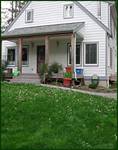

| Shahla Bowen - Spring 2005 | ||
| Introduction | ||
Lush green lawns perform a function more than just looking good. They contribute to the environment in a positive way on several different levels. Lawns play a part in the water cycle by absorbing and holding water and thereby helping reduce storm runoff and improving water quality. They also help reduce air pollution by providing a source of oxygen, a filter for dust and dirt and have a cooling effect for the atmosphere. Below the surface lawns provide an environment for micro-organisms that keep the grass green, and the root system of the grass helps prevent erosion of soils and filters rainwater contaminants from the storm water drainage system. Typical lawn care however, has been adding negative effects to the environment.
A ccording to the U.S. National Wildlife Federation:
• 30% of water consumed on the East Coast goes to watering lawns; 60% on the West Coast. • 18% of municipal solid waste is composed of yard waste. • The average suburban lawn received 10 times as much chemical pesticide per acre as farmland. • Over 70 million tons of fertilizers and pesticides are applied to residential lawns and gardens annually. (Read Healthy lawns, healthy lungs ) • Per hour of operation, a gas lawn mower emits 10-12 times as much hydrocarbon as a typical auto. A weed-eater emits 21 times more and a leaf blower 34 times more. • Where pesticides are used, 60-90% of earthworms are killed. Earthworms are important for soil health.
By changing the types of plants that compose the “lush green” look of a lawn it would also change the type of care needed to maintain it, and by installing a Eco-Lawn into residential and commercial places the impacts on the environment could be more positive than negative. The thought of changing the concept behind a lawn has been sprouting throughout the US and in Europe for several years. Researchers, nurseries and general lawn enthusiasts have been mixing grasses and plants to come up with the perfect mixture that is climate sensitive and still low maintenance. One such example is Tom Cook at Oregon State University who has studied plots planted with various combinations of grasses and broadleaf perennials to discover what thrives as a lush lawn. If the definition of a lawn can change to a more environmentally friendly Eco-lawn, which requires less water, fertilizer and pesticide, the industry that is just blooming will really take off and the positive impacts of a lawn could outweigh the negative impacts on the eco-system.
Statistics from: http://clickserve.cc-dt.com/link/click?lid=41000000008967554 |
||
 |
||